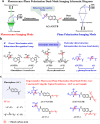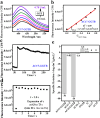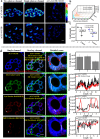Fluorescence-plane polarization for the real-time monitoring of transferase migration in living cells
- PMID: 39309085
- PMCID: PMC11409853
- DOI: 10.1039/d4sc03387f
Fluorescence-plane polarization for the real-time monitoring of transferase migration in living cells
Abstract
Transferases are enzymes that exhibit multisite migration characteristics. Significantly, enzyme activity undergoes changes during this migration process, which inevitably impacts the physiological function of living organisms and can even lead to related malignant diseases. However, research in this field has been severely hindered by the lack of tools for the simultaneous and differential monitoring of site-specific transferase activity. Herein, we propose a novel strategy that integrates a fluorescence signal response with high sensitivity and an optical rotation signal response with superior spatial resolution. To validate the feasibility of this strategy, transferase γ-glutamyltransferase (GGT) was used as a model system to develop dual-mode chiral probes ACx-GGTB (AC17-GGTB and AC15-GGTB) using chiral amino acids as specific bifunctional recognition groups. The probes undergo structural changes under GGT, resulting in the release of bifunctional recognition groups (chiral amino acids) and simultaneously generate fluorescence signals and optical rotation signals. This dual-mode output exhibits high sensitivity and facilitates differentiation of sites. Furthermore, it enables simultaneous and differential detection of GGT activity at different sites during migration. We anticipate that probes developed based on this strategy will facilitate imaging-based monitoring of the activity for other transferases, thus providing an imaging platform suitable for the real-time tracking of transferase activity changes during migration.
This journal is © The Royal Society of Chemistry.
Conflict of interest statement
There are no conflicts to declare.
Figures








Similar articles
-
Recent Advances in the Development of Optical Imaging Probes for γ-Glutamyltranspeptidase.Chembiochem. 2019 Feb 15;20(4):474-487. doi: 10.1002/cbic.201800370. Epub 2018 Sep 19. Chembiochem. 2019. PMID: 30062708 Review.
-
Imaging γ-Glutamyltranspeptidase for tumor identification and resection guidance via enzyme-triggered fluorescent probe.Biomaterials. 2018 Oct;179:1-14. doi: 10.1016/j.biomaterials.2018.06.028. Epub 2018 Jun 21. Biomaterials. 2018. PMID: 29960820
-
γ-Glutamyltranspeptidase fluorescence lifetime response probe for precision tumor detection unveiling A549 cancer cell specificity.Biosens Bioelectron. 2024 Oct 1;261:116484. doi: 10.1016/j.bios.2024.116484. Epub 2024 Jun 6. Biosens Bioelectron. 2024. PMID: 38878698
-
Design Strategy of Fluorescent Probes for Live Drug-Induced Acute Liver Injury Imaging.Acc Chem Res. 2021 Jan 19;54(2):403-415. doi: 10.1021/acs.accounts.0c00646. Epub 2020 Dec 31. Acc Chem Res. 2021. PMID: 33382249
-
γ-Glutamyltranspeptidase (GGT) Sensitive Fluorescence Probes for Cancer Diagnosis; Brief Review.J Fluoresc. 2024 May;34(3):977-1006. doi: 10.1007/s10895-023-03353-6. Epub 2023 Jul 28. J Fluoresc. 2024. PMID: 37505365 Review.
Cited by
-
Sequential metabolic probes illuminate nuclear DNA for discrimination of cancerous and normal cells.Chem Sci. 2025 Mar 11;16(16):6837-6844. doi: 10.1039/d5sc00360a. eCollection 2025 Apr 16. Chem Sci. 2025. PMID: 40110524 Free PMC article.
References
LinkOut - more resources
Full Text Sources
Miscellaneous

